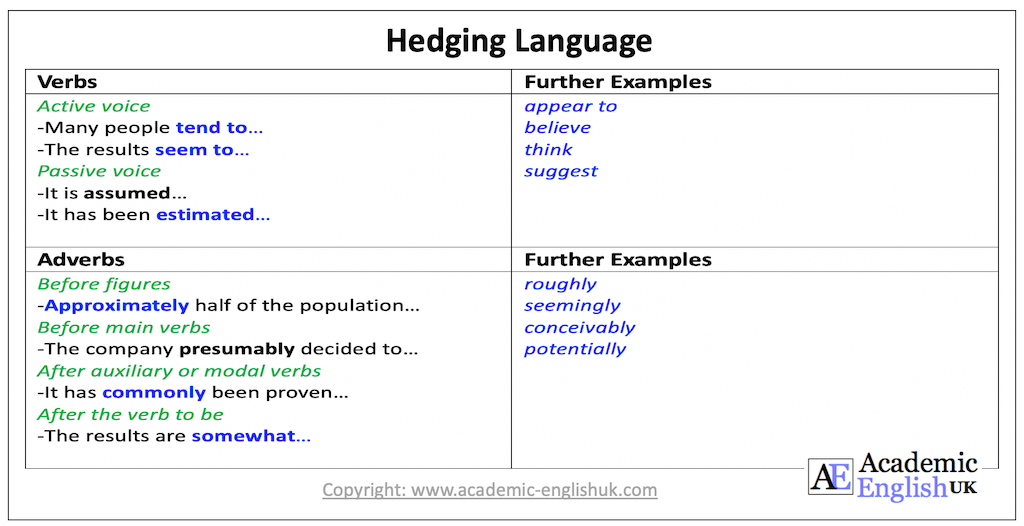Hedging / Caution Phrases
An important feature of academic writing is the concept of cautious language, often called “hedging” or “vague language“. In other words, it is necessary to make decisions about your stance on a particular subject, or the strength of the claims you are making
Hedging Video
If you can’t access this YouTube video in your country, go here
Hedging Language
An important feature of academic writing is the concept of cautious language, often called “hedging” or “vague language“. In other words, it is necessary to make decisions about your stance on a particular subject, or the strength of the claims you are making.
Introductory verbs: e.g. seem, tend, look like, appear to be, think, believe, doubt, be sure, indicate, suggest
Certain lexical verbs: e.g. believe, assume, suggest
Certain modal verbs: e.g. will, must, would, may, might, could
Adverbs of frequency: e.g. often, sometimes, usually
Modal adverbs: e.g. certainly, definitely, clearly, probably, possibly, perhaps, conceivably,
Modal adjectives: e.g. certain, definite, clear, probable, possible
Modal nouns: e.g. assumption, possibility, probability
That clauses e.g. It could be the case that . e.g. It might be suggested that . e.g. There is every hope that .
To-clause + adjective: e.g. It may be possible to obtain . e.g. It is important to develop . e.g. It is useful to study .
Source: http://www.uefap.com/writing/feature/hedge.htm
Hedging Language Exercise
Rewrite these sentences using hedging language.
1.Playing violent video games causes more aggression, bullying, and fighting.
2.Mars is the focus of much scientific study and the foremost planet for human colonisation.
1. It is assumed that playing violent video games may cause more aggression, bullying, and fighting.
2. Mars is certainly the focus of much scientific study and often considered the foremost planet for human colonisation.
For a detailed worksheet and another 6 exercises – buy the Hedging #1 download below.
Hedging #1: Cautious language exercises
This worksheet is for teachers or students. It provides an overview of hedging / cautious language and 8 exercises to practise using hedging language to demonstrate caution. (see worksheet example) Level ***** [B1/B2/C1]. TEACHER MEMBERSHIP / INSTITUTIONAL MEMBERSHIP
Advanced Academic Hedging Lesson
Aim: To support students in their understanding and use of hedging (cautious/tentative) language.
Time: 60 minutes plus homework task.
Hedging #2: Cautious / tentative language
This lesson supports students in their understanding & use of cautious / tentative language.The lesson includes six tasks of guided practice & two tasks of freer practice (see worksheet example) Time: 60mins & homework. Level ***** [B1/B2/C1]. TEACHER MEMBERSHIP / INSTITUTIONAL MEMBERSHIP
More Writing Resources
More digital resources and lessons
Readings
online resources
Tests
online resources
Grammar
online resources
Medical English
online resources
New for 2024
online resources
DropBox Files
Members only
Writing
online resources
Summary
online resources
Vocabulary
online resources
Instant Lessons
online resources
Marking Criteria
online resources
OneDrive Files
Members only
Listening
online resources
Argument
online resources
Critical Thinking
online resources
Topic-lessons
online resources
Feedback Forms
online resources
6-Week Course
Members only
Speaking
online resources
SPSE Essays
online resources
Free Resources
online resources
Charts and graphs
online resources
AEUK The Blog
online resources
12-Week Course
Members only





























